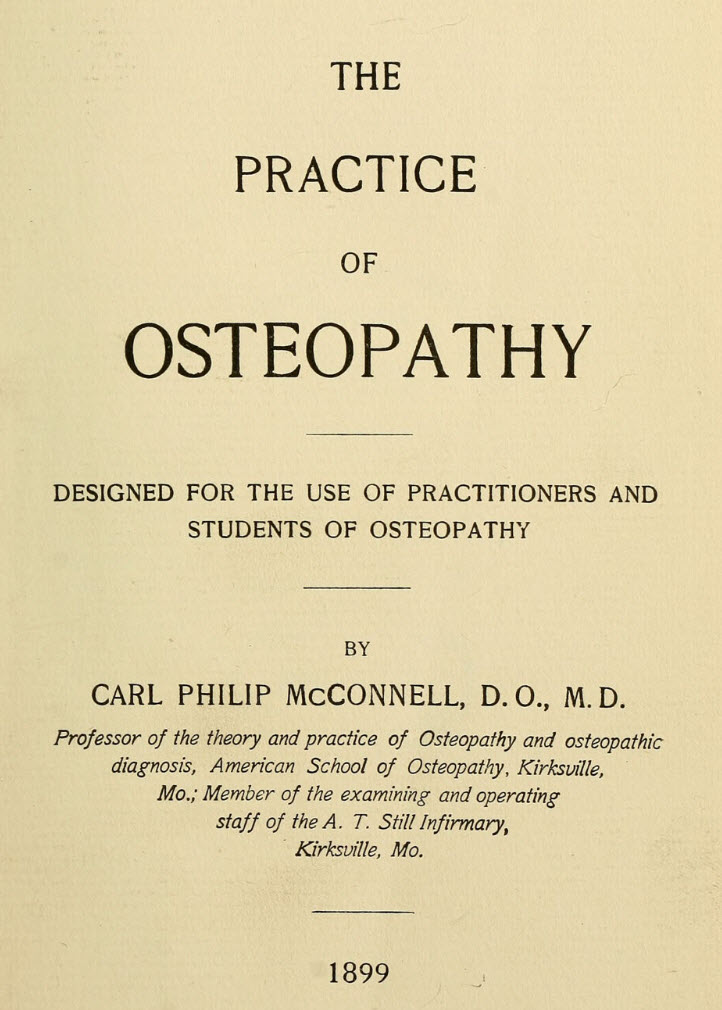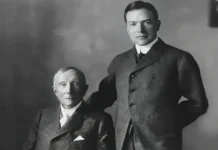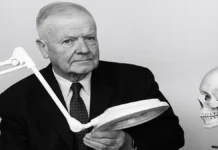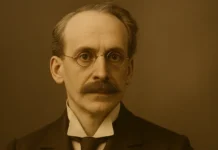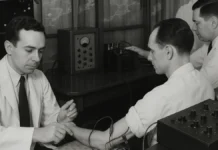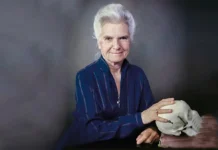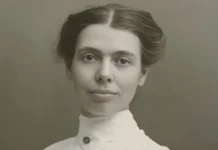Carl P. McConnell, a preeminent figure in the field of osteopathy, stands out as a pioneer who made substantial contributions to the advancement of osteopathic medicine during his illustrious career. Its versatile impact spans diverse dimensions, reflecting a commitment to education, clinical practice, and the integration of osteopathic principles with broader medical philosophies.
Introduction
Carl P. McConnell, DO (1874–1939), remains an iconic figure and a key pioneer in the advancement of osteopathy during the 20th century. Born with an innate passion for understanding the human body and its ability to self-regulate, McConnell has dedicated his life to exploring the fundamental principles of osteopathy and promoting this emerging medical discipline.
As a visionary osteopath, McConnell has contributed significantly to the evolution of the profession by developing innovative techniques and deepening the understanding of the links between body structure and overall health. His extensive research laid the foundation for a more holistic approach to medicine, highlighting the importance of interactions between the musculoskeletal, circulatory and nervous systems.
Beyond his clinical achievements, McConnell played a pivotal role in establishing high educational standards for future osteopaths. As a passionate educator, he has trained generations of practitioners, sharing his knowledge and experience to ensure the sustainability and quality of the profession.
His legacy endures, and the influence of Carl P. McConnell, DO, is still felt in contemporary osteopathic practices. His commitment to constant exploration, innovation and education continues to serve as an inspiration to all who embrace the discipline of osteopathy, perpetuating the vision of a man who indelibly shaped the face of this medical discipline.

Academic Contributions and Educational Leadership
McConnell’s journey began with his graduation from the American School of Osteopathy (ASO) in 1896. His early inclusion on the ASO faculty in 1897 attested not only to his personal achievements but also to his dedication to the education. As a faculty member, McConnell likely played a crucial role in the training of future osteopathic practitioners. His teachings and mentoring likely contributed significantly to the formation of a new generation well versed in osteopathic principles.
Professional Practice and Clinical Innovations
In 1903, McConnell embarked on a collaborative professional journey with his wife, Agnes Russell Darling, establishing a practice in Chicago, Illinois. Their clinical efforts provided practical application of osteopathic principles, potentially contributing to the refinement and advancement of clinical knowledge in the field. Through their collective experiences, McConnell and Darling may have introduced innovative approaches to patient care, further solidifying osteopathy’s place in the overall medical landscape.
Dual Training: Bringing Two Medical Worlds Together
One of McConnell’s distinguishing characteristics is his pursuit of both a Doctor of Osteopathy (DO) degree and a Doctor of Medicine (MD) degree, making him an individual poised to bridge the gap between osteopathic principles and conventional medical practices. This dual training has likely positioned him as a unique advocate for the integration of holistic and conventional medical approaches.
Literary Contributions: Reconciling Philosophical Divisions
The writings of J. Martin Littlejohn McConnell, illustrate a deep commitment to overcoming philosophical divisions within the medical field. His work emerges as a significant testament to his efforts to reconcile the divergent philosophies of Andrew Still, founder of osteopathy, and Sir William Osler, a leading figure in conventional medicine. This attempted marriage between two distinct medical approaches was clearly discernible in his publications, where McConnell sought to foster a nuanced understanding and broader acceptance of osteopathy within the medical community.
McConnell had a bold vision to transcend the barriers between osteopathy and conventional medicine, two fields that, at the time, might seem diametrically opposed. In his writings he explored the possibility of a convergence between osteopathic principles, emphasizing the structure and function of the body, and more traditional approaches to medicine which often focused on disease as an entity. distinct.
It is important to note that McConnell did not seek to dilute the fundamental principles of osteopathy in his desire to harmonize different medical perspectives. On the contrary, he sought to highlight points of convergence, areas where osteopathy and conventional medicine could complement each other. He developed a compelling argument for the need to recognize the value of both approaches to providing comprehensive, holistic patient care.
McConnell’s work thus laid the foundations for a constructive dialogue between the two medical schools of thought, promoting the idea that medicine can be enriched by integrating diverse perspectives. By highlighting similarities and potential synergies, he helped to overcome prejudices and pave the way for wider acceptance of osteopathy.
McConnell’s legacy lies in his ability to transcend divides and work toward more inclusive medicine. His bold vision left a lasting imprint, encouraging collaboration between osteopathic practitioners and those of conventional medicine. As such, McConnell’s writings remain a source of inspiration for health professionals seeking to integrate diverse medical approaches for the benefit of comprehensive understanding and holistic care of patients.
Lists compelling arguments on the need to recognize the value of both approaches to providing comprehensive and holistic patient care.
J. Martin Littlejohn McConnell’s legacy is based on compelling arguments highlighting the need to recognize the value of both approaches, osteopathic and conventional medicine, to provide comprehensive, holistic care to patients:
- Complementary approach: Osteopathy and conventional medicine are complementary in their approach to health care. Osteopathy focuses on the structure and function of the body, while conventional medicine addresses specific symptoms and illnesses. Together, they form an integrated approach that covers all health needs.
- Taking into account the whole patient: Osteopathy, with its holistic approach, considers the patient as a whole, taking into account the physical, emotional and environmental aspects of health. Conventional medicine, by integrating this perspective, can provide more comprehensive care by considering the individual as a whole.
- Preventive approach: Osteopathy is characterized by a preventative approach, identifying and treating structural imbalances before they lead to more serious health problems. Integrating this preventive dimension with the curative treatments of conventional medicine helps promote long-term health.
- Reduction of side effects: Osteopathy often offers non-invasive and natural methods, potentially reducing the side effects associated with certain medical treatments. This approach may be beneficial for patients seeking alternatives to more traditional medications.
- Individualization of care: Combining approaches makes it possible to individualize care, meeting the specific needs of each patient. This personalization contributes to more sustainable results by taking into account the preferences and particularities of each individual.
- Approach centered on well-being: By combining the perspectives of osteopathy, focused on prevention and well-being, with conventional medical treatments, we can create an approach centered on the overall well-being of patients, going to the beyond simple symptom management.
Philosophical Integration: A Holistic Approach to Health Care
The work of J. Martin Littlejohn McConnell is notable for his continuing effort to reconcile the osteopathic philosophies of Andrew Still with those of Sir William Osler, a prominent figure in conventional medicine at the turn of the 20th century. This commitment highlights McConnell’s deep interest in integrating the strengths of both approaches, underscoring his forward-thinking vision for health care.
The founder of osteopathy, Andrew Still, advocated a holistic approach to the body, emphasizing the body’s inherent ability to self-regulate and self-heal. On the other hand, Sir William Osler, considered the father of modern medicine, emphasized a more traditional approach, focused on understanding specific diseases and managing symptoms.
McConnell, in seeking to reconcile these two seemingly divergent philosophies, demonstrates his commitment to a comprehensive and holistic understanding of health care. He recognized the respective strengths of osteopathy in its global approach to the patient and of conventional medicine in its analytical approach to specific diseases.
This philosophical integration anticipated the shift in the medical landscape toward integrative medicine, which combines conventional and complementary approaches to provide comprehensive care. McConnell’s approach highlights the need to transcend boundaries between different schools of medical thought to provide care that encompasses the entirety of an individual’s health experience.
In seeking to harmonize the philosophies of Andrew Still and William Osler, McConnell sought to create a synthesis that could benefit patients by leveraging the strengths of both approaches. This quest demonstrates his enlightened vision on the need to explore varied medical horizons to comprehensively respond to the complex and diverse health needs of the population.
McConnell’s legacy lies in his contribution to promoting an inclusive approach to medicine, embracing the diversity of approaches for optimal well-being. His avant-garde approach laid the foundations for closer collaboration between osteopathic practitioners and those of conventional medicine, thus contributing to the continued evolution of health care towards an integrative and holistic vision. By embracing the richness of different perspectives, McConnell has paved the way for a more comprehensive, patient-centered medicine poised to harness the best of all approaches to promote overall health.
Advocating for Osteopathy: A Voice for Recognition
McConnell’s involvement in osteopathic and homeopathic practices distinguishes him as a strong advocate for the recognition and acceptance of osteopathy within broader medical circles. This involvement reflects a holistic approach to medicine, emphasizing the idea that health can only be fully understood and treated when we consider the body as a whole.
His diverse educational background, which has included both osteopathy and homeopathy, has played a crucial role in promoting collaboration between different medical communities. This diversity has probably facilitated dialogue between practitioners of osteopathy and those of conventional medicine. Indeed, McConnell’s in-depth understanding of the ins and outs of these two approaches created a bridge between the medical worlds, fostering fruitful communication and mutual recognition of the benefits of each discipline.
The gradual integration of osteopathy into conventional health care has benefited from the influence of figures such as McConnell. By advocating for a more inclusive approach to medicine, he helped break down traditional barriers between medical disciplines, encouraging a collaborative approach to patient well-being.
McConnell’s legacy lies in his pioneering role in paving the way for wider recognition of osteopathy. His advocacy for integrative medicine, combining the principles of osteopathy with other medical modalities, helped broaden the perspective of health professionals. Thus, McConnell’s influence is felt not only in osteopathic practices, but also in the gradual evolution of standards and attitudes within the broader medical field.
Contributions to the Evolution of Osteopathic Thought
Beyond the immediate impact of his writings and teachings, McConnell’s exploration of the philosophical intersections between osteopathy and conventional medicine played a crucial role in the formation of osteopathic thought. His work likely influenced later generations of osteopathic physicians, promoting a more inclusive and integrative approach to health care.
In summary, Carl P. McConnell, DO, emerges as a crucial figure whose contributions to osteopathy extend far beyond the confines of his immediate career. His legacy lives on in the continued growth and integration of osteopathic principles into the overall medical landscape, testament to his lasting impact on the field.


